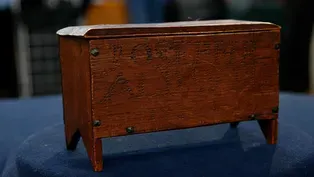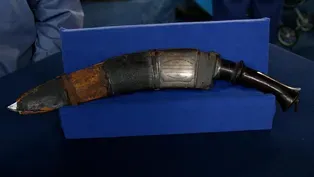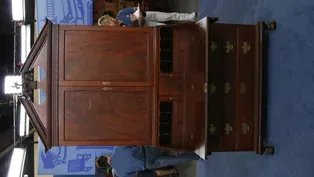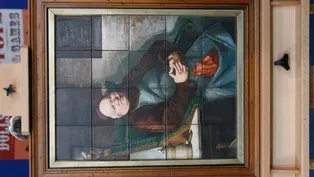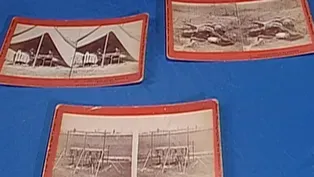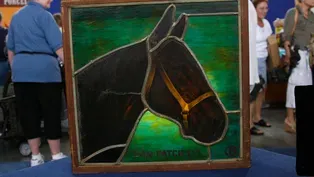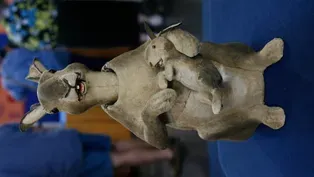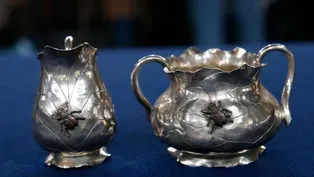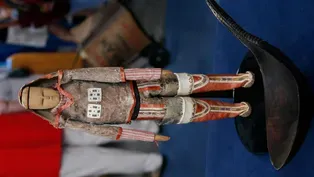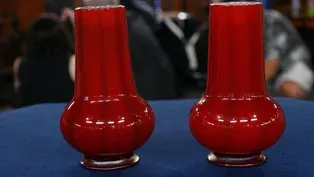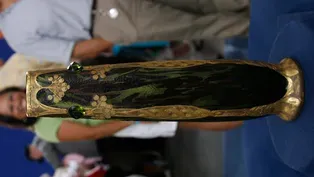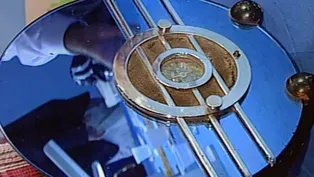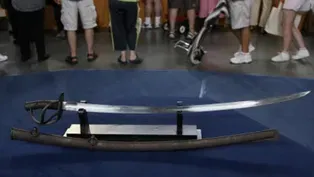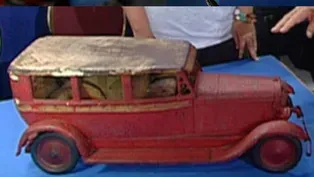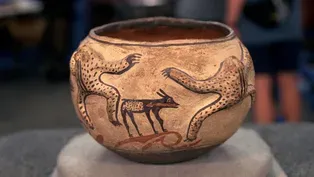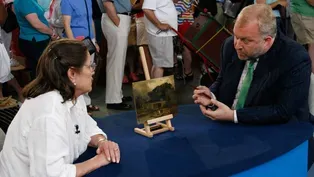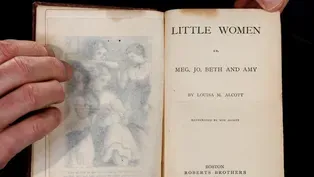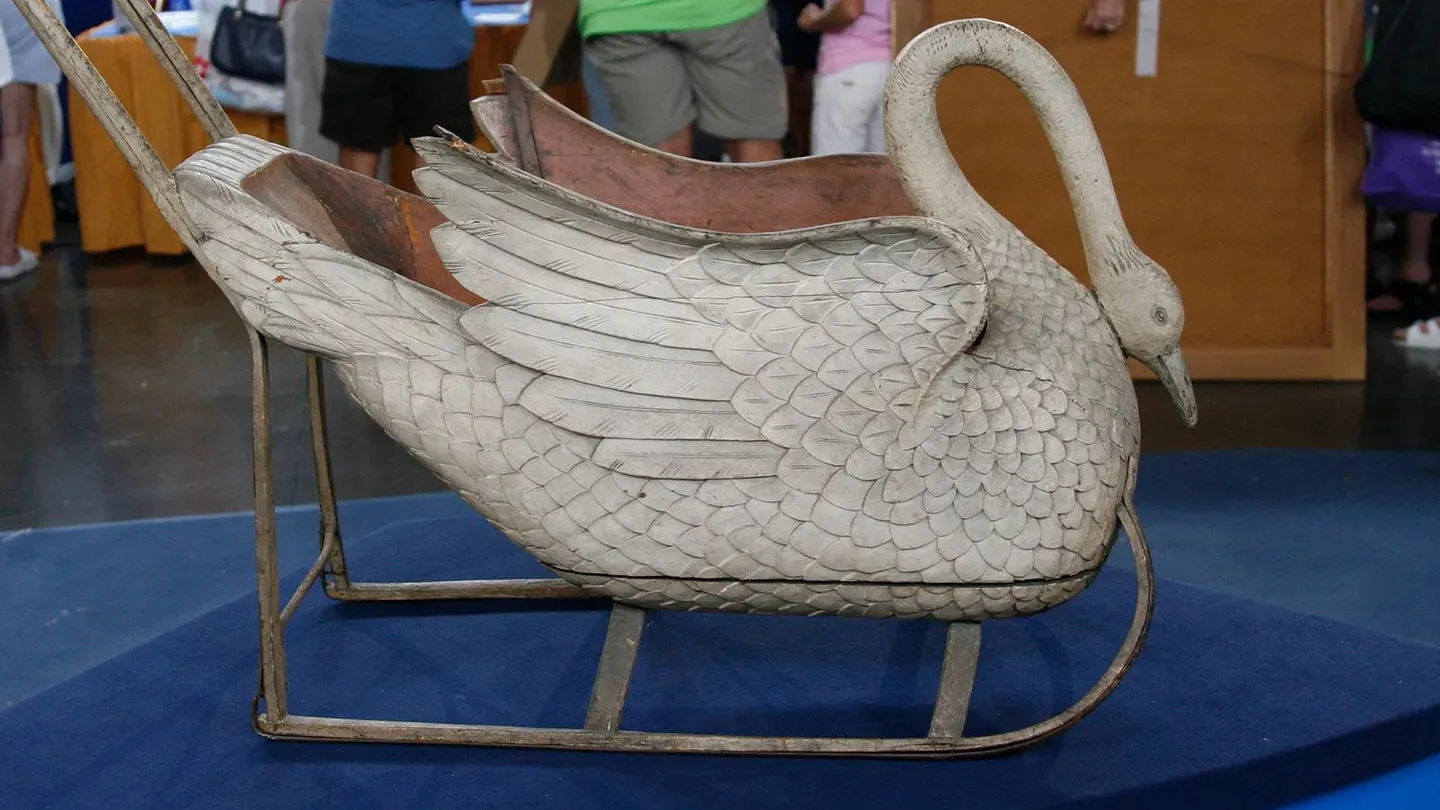

Vintage Milwaukee 2020
Season 24 Episode 17 | 52m 31sVideo has Closed Captions
Discover which magnificent Milwaukee treasure has an updated value of $70K-$100K and more!
Discover magnificent Milwaukee treasures including 1869 Louisa May Alcott "Little Women" books, a Samuel Prince desk and bookcase made around 1775, and a child's swan sled from about 1880. Which has an updated value of $70,000-$100,000?
Problems with Closed Captions? Closed Captioning Feedback
Problems with Closed Captions? Closed Captioning Feedback
Funding for ANTIQUES ROADSHOW is provided by Ancestry and American Cruise Lines. Additional funding is provided by public television viewers.

Vintage Milwaukee 2020
Season 24 Episode 17 | 52m 31sVideo has Closed Captions
Discover magnificent Milwaukee treasures including 1869 Louisa May Alcott "Little Women" books, a Samuel Prince desk and bookcase made around 1775, and a child's swan sled from about 1880. Which has an updated value of $70,000-$100,000?
Problems with Closed Captions? Closed Captioning Feedback
How to Watch Antiques Roadshow
Antiques Roadshow is available to stream on pbs.org and the free PBS App, available on iPhone, Apple TV, Android TV, Android smartphones, Amazon Fire TV, Amazon Fire Tablet, Roku, Samsung Smart TV, and Vizio.
Buy Now

ANTIQUES ROADSHOW 2025 Tour!
Enter now for a chance to win free tickets to ANTIQUES ROADSHOW's 2025 Tour! Plus, see which cities we're headed to!Providing Support for PBS.org
Learn Moreabout PBS online sponsorship♪ ♪ Leigh and I rarely appraise pieces together.
You were like my hound dog going hunting when all of a sudden you... leapt on it.
Whoo!
(laughing) No kidding!
I could just cry.
I had no idea.
♪ ♪ CORAL PEÑA: In 2006, when "Antiques Roadshow" visited Milwaukee, Wisconsin, for the second time, we found local treasures... APPRAISER: You brought in a directory of the city of Milwaukee.
PEÑA: And gems from all over the world.
APPRAISER: That inscription makes this thing.
And makes it pretty much a national treasure.
Oh, dear... For someone of Indian origins.
Yeah.
PEÑA: 14 years later, we wanted to know, did the values for these and the other objects we saw go up, down, or stay the same?
Find out as we take another look at Milwaukee.
I see you've brought two little books with you today.
Yes.
They're very aptly titled "Little Women."
Can you tell me how you got these books?
My grandpa gave it to my grandma for Christmas.
Her name was Jo, and she was also a writer, like in the book.
Right, like in the book, "Little Women," exactly.
And my aunts all have one of the names in the book.
My grandma gave it to my aunts, and my aunt gave it to me.
Do you know what I mean when I'm mentioning the word "first editions"?
It was one of the first ones printed.
Good, that's exactly right.
And "Little Women" was written by Louisa May Alcott.
And it was first published in Boston in 1868.
And it was so popular and sold so many copies, that she wrote a sequel, part the second, that was published in 1869.
So what you've got here, by gift from your aunt, is an 1869 first edition, second state, of "Little Women," and a proper first edition of the second.
And the two are in their original cloth binding, as published.
There's some wear to the book, but many copies that I've seen have got handling wear, fading of the purple on the spine and covers.
And this part one, which is the more important one, has got a long tear around here.
Now, do you have any questions for me about the books?
Why is there... tissue paper right here?
Now, that's a very good question.
This is called a frontispiece-- the first illustration in the book.
It faces the title page.
And this tissue is there to prevent the print offsetting onto the title.
The value of this set, for auction purposes, I would put at $3,000 to $5,000.
And thank you very much for coming in.
I was a pretty young guy, probably about 15 or 16 years old, and I was up at an antiques store in northern Wisconsin.
I was with my, my mother.
We had went up there on vacation.
And I said, "Gee, I'd sure like to have that spoon, or the ladle."
And she says, "Well, if you want it, I'll buy it for you.
Your birthday is coming up, I'll buy it for you."
1957.
I've had it all these years.
I think it's made out of a buffalo horn, but I'm not exactly sure, because some of the books I've been looking in, the Northwest coast had spoons similar to that that were made out of a mountain sheep horn.
It's mountain sheep.
Is it mountain sheep?
Oh, good.
Yeah.
You can tell when you turn it over.
You can see how it's got these ridges that go around it, and that's the ridges of the horn where they polished it off.
And it's from Canada.
It's Athabascan.
And it's for serving.
How did you get the doll?
A fella had a tavern, and I read a little article that he was selling.
He was 85 years old and he was selling out what little stuff he had.
But he said that he had got it from a fella that had found it in a dump, believe it or not.
(laughing): In the dump.
In a dump.
Judging from the way it's made and the looks of it, it's probably a hundred years old or more.
Okay.
It's hard to tell, because things change so little.
They were made to sell, but also, the children played with them in the tribe.
The embroidery is gorgeous, and what that is, it's seal gut that's been dyed and used to embroider the pieces.
And I can take this boot off, and you can see how it's all carved wood and it's been pinned together.
And it's really kind of cool, because this is articulated.
You can move the legs and the arms, and it's got carved wood hands, and they're pinned, also.
And the boot is just incredibly made.
I mean, there are collectors who would go just for the boots.
Um... Is that right?
But don't see very many of the figures.
How much did you pay for the doll?
I think I paid around $25 for the doll.
It sounded like a good deal to me at the time.
And you paid $15 for this?
Nine dollars.
Back in the '50s, you know, money didn't grow on trees, and that was a good sum of money, but that was my birthday gift.
It's a pretty good birthday gift.
And it's great that you still have it.
I don't have any of mine.
This spoon is not very decorated, but even so, it's an early one.
It's well over a hundred years old.
Okay.
150 years old, at least.
It could even be older than that.
It shows a lot of wear.
And it was not made to sell, it was made for use by the tribe.
Easily $800 to $1,000.
(chuckling): Wow, well, that's good to hear.
I'm happy to hear that.
$800 to a thou, wow.
On the doll, they're rare.
They don't show up this early very often.
Really?
I had somebody at the table look up all the records on sales for the past five years or so.
There was one, $2,000 to $3,000.
Oh, my... Wow.
So, pretty good buy.
That's incredible.
You brought in a directory of the city of Milwaukee, which is, you know, a phone book or an early, early document of the city of Milwaukee of that time.
What is interesting about it is that it is produced in the second year.
Milwaukee was founded in 1846.
This is from 1848.
So it is an interesting historical document in its original binding.
This is a style of chair you see a lot in French furniture.
They're making them now, but they originally started making them in the 1700s.
So this is an 18th-century French chair.
Although it is quite old... Yeah.
They made a lot of these chairs.
It was my grandfather's.
And he got it when he was born.
A neighbor across the street where he lived made it for him when he was born, in about 1918.
APPRAISER: Well, you know, a lot of times, the stories that come down through family history and everything, sometimes there are little problems.
Okay.
Sometimes they're good problems and sometimes they're bad problems.
This is a good problem.
(laughs): Okay.
This is a manufactured toy.
Oh.
And it is made by a company called Turner.
It's a Turner Lincoln.
Okay.
It dates from the 1920s.
Even though it has this problem of, somebody put some paint on here.
Right.
And that's not original to the piece.
And even though it's missing a trunk... Oh.
It does have its headlights, steering wheel, bumper.
Mm-hmm.
At auction, in this condition, even with this paint on here...
Right.
We would estimate this at $3,000 to $4,000.
Hmm.
A little better than handmade.
Yeah, definitely.
(both laughing) WOMAN: I got it at a rummage sale about seven years ago.
I paid about $35 for it.
I bought it in the Fond du Lac area.
I think it came from Waupun, which, there are a lot of Dutch people in Waupun, and basically, that's all I know about it.
What we have here is a child's sled, but it really transcends being a sled and it falls into the category of American folk sculpture.
It is American, it's pine.
It's an unknown maker.
It was not mass-produced.
It's beautifully constructed and beautifully carved.
And it was made to be used.
And that's what's so wonderful about it in terms of folk sculpture.
You have this screw here that was probably painted over, but it's now visible because the paint has popped off of it.
And that attached and made the head stronger, so the child could hold on to it and it would not break.
You have these metal braces inside which curve with the shape of the wing.
30 years ago, we would have said it's unique.
But about 20 years ago, another sled, same form, surfaced.
Oh.
And it's approximately twice the size of this one.
Oh, my gosh.
So that leads me to speculate that it might have been made by the same maker for a younger child-- the larger sled being for the older child.
Beautifully made, beautiful shaped wood, runners, underneath, is the metal.
Probably the only thing that wasn't made was this handle, that was turned and probably salvaged off a Victorian doll carriage, something like that.
Okay.
I would value it at somewhere around $20,000 to $30,000.
Oh, my gosh.
I could just cry, I had no idea.
It's a wonderful, wonderful object.
Wow.
So I just thank you today for bringing it in to "Antiques Roadshow."
Well... And sharing it with us.
Well, thank you so much.
I just never had an idea it would be anything like that.
APPRAISER: This kind of a single-edged, curved-bladed weapon is the national weapon of Nepal, and it's called a kukri.
And it's a fairly average one, but it does have a plaque that's on there.
It does, yes.
And you knew a little information about that plaque.
Supposedly this is a war souvenir from the Sepoy Rebellion that occurred, like, 1857 to 1859.
When a major rebel of that battle was taken captive, the major who obtained this kukri then presented it to the first viceroy of India, presented as, uh...
Proof, I guess, that the battle was over.
Well, you know, that information is all true.
This was the first major revolt for Indian independence.
They talk about Nana here.
He's a character called Nana Sahib, and Nana Sahib was a Maratha leader from Central India.
And he was disenfranchised by the British.
And the British basically took his state away from him.
He was very upset, I guess.
Exactly, and he sent a character named Azimullah Khan to England to try to get his rights restored.
And Azimullah Khan came back from England and he said to Nana Sahib, he said, "How can a country "that's as poor and as desolate as England rule India?"
Yeah.
And he talked Nana Sahib into a major revolt.
And one of the generals here was this Tantia Tope.
And in 1858, he was driven into Nepal, where he probably captured this weapon.
And then in 1859, he was captured by this Meade that, who's on here.
Right.
It's the kind of thing, if you look at it, it's not much to speak of, but that inscription makes this thing and makes it actually pretty much a national treasure for someone of Indian origins.
Oh, dear, yeah?
In fact, they hunted tigers with these things.
Oh, did they?
They got that close with that small of a knife?
Yep, yeah, yeah.
The Gurkhas were fearless people, and... You had purchased it?
Yes, we purchased it in Colorado about ten years ago at a regular antique mall.
Yeah.
Really?
Wow.
Yeah.
And what did you pay for it?
$300.
Yeah, I think that was very reasonable.
I think it, conservatively, is worth a retail value of probably around $3,000.
That's very good.
Yeah.
My husband will be really happy.
WOMAN: They were given to me by my father, and he said that they'd been in his family all his life, that he had gotten them from his mother's side of the family.
I don't know how long they had them.
They are very naturalistic.
They're in the shape of leaves and they're applied with copper insects.
This was a style that was very popular around 1880, 1890 in America.
It was the Orientalist movement, and it was reaction to the opening of Japan and China in the late 19th century.
They're by a company called George Shiebler.
You see the maker's mark right here.
The retailer is Theodore B. Starr.
Now, George Shiebler started its company with five men in 1876.
George Shiebler was one of the biggest makers of novelty items.
He didn't go for run-of-the-mill stuff.
His stuff was so kooky and funky, and there's a big collecting contingent.
You'll see that the detail is so fine...
Sometimes, around this time, you'll see insects or birds or reptiles applied in different metals besides copper-- silver, gold...
This sugar bowl is lined with gold.
Just ordinary creamer and sugar around this time period by an ordinary, late- 19th-century American maker would probably be worth about $50 to $75, but because they're by Shiebler, and they're in the American Orientalist style, they're worth about $800 to $1,200 for the two pieces.
At auction.
Wow.
WOMAN: Well, my father-in-law played in a cowboy band back in the '50s and '60s.
And he bought this guitar in 1954 for $300, and played it for several years, and then it kind of got put in the basement for about 50 years, and he passed away a couple of years ago and gave it to my husband.
He so enjoyed it his whole life.
And my husband plays the guitar and he wanted my husband to have it, so...
Here we are today.
You brought in a Fender Esquire, different from the Telecaster in the sense that it only is fitted out with one pickup, which gives it this wonderful, twangy, hard sound that country-western players loved.
Ah, okay.
Which is why he probably chose this guitar.
Uh-huh.
It is the guitar that Stephen Stills built a career on.
It's a guitar that David Bromberg built a career on.
It is the model of guitar that Bruce Springsteen built his career on.
There's a lot of different methodologies of dating these instruments, one of which is to pull the instrument apart and look at the dating processes inside.
But we don't need to do that today.
We're going to sort of unweave a little puzzle here that's sort of put together.
Okay.
Um, great, great instrument, survives with its original bridge cover that they call the ashtray.
(chuckling): Oh, yeah, I see it.
And that's why they call it that.
And the bridge bears a serial number, and that serial number is 0-3-4-9.
Pretty early for Fender.
Between 1950 and 1952, this series of serial numbers pops up.
But we're not sure where in the equation.
Yeah.
So, we want to look at it a little bit closer, and when we turn it around and look at the back, where later serial numbers turn up, on the neck plate... Yeah.
There's nothing here.
Right.
That's a good thing.
We don't want to see anything there.
But suddenly, we see the screws are Phillips head screws-- these four bolts that hold the neck in place-- and that tells me that it was made at some point in 1952, because prior to 1952... Yeah.
Straight screws.
Straight screws.
Ah!
Interesting.
Like the screws used on the pick guard.
Fabulous condition on this instrument.
And it has something else, another determinant of value, and that is freshness to the market.
I would advise an insurance valuation on this guitar of $35,000.
Oh, my gosh.
Okay.
My husband will be very happy.
(both laughing) This is a piece of North Dakota School of Mines.
It's clearly marked as such.
This one is also signed by Flora Huckfield, who was one of the, one of the teachers at the school.
School of Mines.
And consequently, the quality is better.
They made a lot of pottery there.
They made a lot of commercial pottery produced by the students.
But every once in a while, one of the instructors steps out and makes something really special, and this is one such piece.
It's reminiscent of the Arts & Crafts period.
It's probably from the '20s or late '20s.
These now, apparently, as I understand it, were made by... MAN: South Bend Toy Company.
South Bend Toy Company made them for Studebaker.
They said that some of them were actually used in the stores as replicas of their wood wagons.
APPRAISER: The thing that's so special about it is that it, it retains most of its original color.
WOMAN: My Grandmother Chim gave it to me a few years ago, and she got it from a bookstore, and she went in to get a children's book, and she saw this and recognized the signature, and it said ten dollars.
And, um, she wanted to buy it, and the sales clerk thought, "Oh," you know, "there must be a mistake," because there's a signature, and wanted to, my grandmother to come back, and, um, after she had checked to see if the price was right.
My grandmother said, "No, no," you know.
"I have to leave right now, can I buy it?"
So she got it for ten dollars.
Amazing.
Well, what's the book?
That's the question.
It is "When We Were Very Young" by A.A. Milne.
It's one of the four Pooh books from the famous "Winnie-the-Pooh" series.
And you're absolutely right that it is signed by the author, A.A. Milne.
So she had a very good eye, and it was a very good purchase.
It's the first edition of the book.
The book was issued with a dust jacket.
This copy doesn't have the dust jacket, it just has the original cloth cover.
But what's it worth now?
It was ten dollars then.
Now we would place an estimate of $4,000 to $6,000, if it were to come up at auction.
Yeah.
There's a tremendous interest in Milne and it was an incredible buy, and we love seeing it in great condition, great provenance, great story.
Thanks.
Thanks.
(laughs) WOMAN: Well, I saw them at a house sale.
I was paying for another piece-- in fact, I'd just finished paying for it-- and I saw them sitting on a windowsill, and the light shined through one of them, and I was thinking I needed a red vase, so I went back and went over and looked at them, and ended up picking them up, and saw the signature on them, and it says Tiffany, and I don't know whether they're really Tiffany or not really Tiffany, but I thought they were very pretty red vases that I needed for flowers.
First thing that I want to bring to attention is this tape on the piece.
(laughing): Yes.
And you, you got these how long ago?
Oh, I'd say five, six months ago.
Okay, and as we can see, it says "$10.00" on there.
It still says ten dollars on there.
Okay.
I purchased them both.
I believe they were both ten dollars, so I think this one had a ten-dollar tape on it, too, that I did get the tape off of that one.
Okay, well, when you find a pair that are high-end-type pieces, you should be suspicious to begin with.
One would then compare the signatures on the piece.
We did that at the table earlier, when you had your back turned.
And the shape is rather classic.
And it has a nice iridized foot.
They have nice striations on the inside.
And it's a cased glass.
Yes.
So, we try to then form an opinion, do we have a reproduction here, because it's a pair... Sure.
And the odds of finding a ten-dollar Tiffany vase... Sure, yes.
Very slim, I thought so myself.
Yeah, very slim.
(laughs): Yes.
However, we're going to get fatter, because you have a wonderful eye for glass.
Oh, really?
And these are, in fact, Tiffany.
Oh, my goodness-- oh, my goodness!
And... Oh, that's a thrill to know.
They're worth $10,000 to $15,000 retail for the pair.
Are you serious?
I am serious.
(laughing): Oh, my goodness.
I am serious.
Oh, I think I better take the ten-dollar tag off.
I cannot believe it.
(both laughing) MAN: It was given to me by my aunt before she passed away.
It was laying around the house, and she said she just wanted to get rid of it.
I told her not to.
Mm-hmm.
Because of its age.
Right.
But she said, "Go ahead and take it."
So I took it.
And then I just hung on to it, and these people came by, and they were buying toys.
And they offered me $900 for it.
Okay.
So that piqued my interest a little bit more.
Sure.
I looked in some books, but they always say "if it's in this condition" or "that condition," and I don't know what condition it's in.
It's a Lionel Number 1536 Mickey Mouse Circus Train.
And we have it in excellent condition.
There is a little bit of wear on the train, but it's one of the greatest whimsical Lionel Disney pieces.
If you look down the side of the train, there's all the Disney characters lithographed on the sides.
It's just fantastic imagery.
One of the great things about the train itself is, you have Mickey shoveling coal in the tender, and it's animated.
(laughing) And as it goes along, it shows Mickey shoveling the coal, which is very comical.
It just has such charm.
Yeah, I've never had it running, so I've never seen that.
Also, a wonderful part of the set is its original box.
Now, we haven't shown everything.
There's also a ticket booth and lots of cut-outs of characters.
Inside, we also have the large-composition Mickey ticket-taker.
Now, all that fit inside this box.
This all breaks down.
It's a play thing, and it's made out of cardboard.
(laughs): Yeah.
So a kid would open it up on Christmas, and probably set it up once, and the cardboard gets thrown away and they play with the train.
So you do find the trains, but very, very, very rarely do you find the tent.
And that's what makes this set really good.
Now, there's a little bit of condition issues.
On the, uh, tent there's a few little tears, wear on the edges and things, but it's not a really huge deal.
It's well preserved, the whole thing.
In all your research, did you come along any pricing?
Well, one book that said it could be worth from $1,000 to $3,000.
Then I saw another book, and they said $700 to $2,000.
So it was all over the place.
Right.
So it's hard to tell.
Yes.
And you have to be, at this level, very picky about condition.
It's not mint.
A mint example would obviously bring a little bit more.
This example is extremely fine, and it's one of the greatest Disney, Mickey Mouse toys from the '30s.
The proper auction estimate for the condition that we have here is $10,000 to $12,000.
(chortles): Oh!
And it could bring, you know, a little bit more.
Wow.
Yeah.
That's a lot more than I anticipated.
(both laughing) WOMAN: My mother- and father- in-law were trying to furnish a second home-- this was about 40 years ago, so everything's a little sketchy-- but they bought this and a couple of other paintings at a flea market somewhere in the New York area.
And then it stayed in this apartment.
And when we dismantled it, we saw it, and have been a little curious about it from that point on.
It's signed.
And we looked, um, up the, the name and they just said it was a 19th-century American artist, and other than that, we really don't know.
It is American.
It's an artist called Edward Mitchell Bannister.
One of the reasons he's famous, he was the first African-American artist to come to national prominence.
Huh.
And the first to win a national award, in fact.
And he had an interesting background.
He was born in New Brunswick in Canada in 1828.
Just shortly after that, the British abolished slavery in the provinces.
And he had always had an interest in drawing and painting, from a young age.
This is actually painted in 1879, and he died in 1901.
So this is a slightly later work.
It's likely to have been painted in Rhode Island-- Providence-- which is the town that he's most associated with.
Providence.
He's Canadian, but everyone thinks of him as American now.
I see.
Because that's where he settled.
Sadly for him, both his parents passed away before he was 16, and his mother was a great source of encouragement to him in his artistic pursuits, and he ended up doing...
He was a ship's cook for a while, he was a barber in Boston.
Hm.
He got involved in photography.
But all this time, he was carrying on doing painting.
And then he had the good fortune to meet the love of his life, who happened to be a New York City businesswoman.
And following that marriage, he was able to spend more time doing what he really loved, which was painting-- he had a studio.
Very religious fellow, had great empathy with nature.
And because of that, he found a lot of inspiration in the Barbizon School.
Mm-hmm.
The French Barbizon School, who, of course, foreshadowed the Impressionists.
And you can see the Impressionist-style painting here.
Yeah.
It's very, very evocative.
And this is fairly typical of him, to be painting cattle.
Not many works by him come up in the market.
Now, in spite of the fact there are one or two little dents, dings, scratches... Yeah, right.
These aren't major.
Probably would benefit from a frame.
Bear in mind, a frame isn't just for decoration-- it's also to protect a painting.
Mm-hmm.
So they got it at a flea market.
How much do you think they would have paid for it?
I have... Well, not much.
If they paid $50 for it, I'd be really surprised.
Okay.
So would it surprise you further to learn that it's worth, at auction, I would say $6,000 to $10,000?
Yeah.
Yeah, yeah.
Yeah... His work really is very much in demand, particularly amongst collectors of African-American art.
Jeez.
When we were cleaning out this apartment, we came this close to tossing it in a dumpster, because it was sort of, like, "Huh?
What's this?"
Whoops.
It wasn't canvas, it wasn't... Yeah, so, um... Yeah, glad you didn't.
That is just incredible.
APPRAISER: It's a tin litho, and it's advertising.
On the side here, you have Goodyear, you have "Goodyear Zeppelin" on it.
So it's gonna appeal to people who collect Goodyear tire material.
It also appeals to aviation collectors, and that to me is the real interesting part, because there are people who collect zeppelin material and they just absolutely love it.
The fact that it's still working after all these years is remarkable.
WOMAN: I believe it is a raincoat from Taiwan.
APPRAISER: Okay.
It's a rain outfit worn by the rice farmers.
It's missing the hat, which would have been a high-peaked hat.
It's made of rice straw.
Nothing but a garment like this could keep them dry.
WOMAN: My great-grandfather was a photographer.
I'm assuming they came from his photography studio.
He didn't take these pictures, of course.
No, no.
All of these photographs were taken during the Civil War by Mathew Brady or, or one of Brady's operatives.
Okay.
And they're a great story, because these were originally issued during the 1860s.
Brady fell on hard times, and after the war, he became bankrupt, and all these negatives then passed to a company in Hartford, Connecticut-- Taylor & Huntington-- and they issued these in the 1880s.
The original Brady-era issue stereographs from the '60s are worth more than these.
And you can tell the difference, because the earlier ones were on yellow cards.
Okay.
And they often say along the side, "Photographic History of War for the Union."
These are later.
They're on these large orange cards.
Mm-hmm.
You happen to own some really valuable later ones, though.
Okay.
Lincoln at Antietam.
Yeah.
That card's probably worth close to a thousand dollars.
Oh, my.
(laughs) This is the hanging of the Lincoln conspirators.
Uh-huh.
And that, that photograph was actually taken by Alexander Gardner.
Now, if you had the original Gardner photograph, it would be worth about $2,500.
Oh, my.
Still, that's probably worth close to a thousand dollars.
Okay.
Just because it's such a rare image.
You start flipping through here, and you have several thousand dollars' worth of cards here.
Okay.
And you think you might have more, right?
Yeah, Dad said there's more in the shoebox.
Well, congratulations.
You got quite a find.
Thank you.
WOMAN: This was given to me this weekend, actually, before I came to the Roadshow, by my grandma.
And it's always been on the top of her bookshelf in the living room, and she wanted me to have it as a wedding present.
This is an absolute little jewel of a piece of American furniture.
It is a miniature six-board, bootjack-end blanket chest, of which there were thousands and thousands of them made.
Every home in New England had the full-size ones to store their blankets in when they weren't using them.
The front of this says, "Joseph Baldwin, 1723," in pinprick decoration.
Now, what do you know about Joseph Baldwin?
Well, I know he was born September 14, 1702, so he was 21 when he made it.
And I know he was from Massachusetts.
We were able to track him down by my great-grandmother's Daughters of the Revolution certificate, so he is an ancestor of mine.
The features are so wonderful on this piece.
Number one, the pinprick decoration.
You have rose-head nails here on the front.
You have this bootjack end, which is so typical of this type of blanket chest in the larger model.
And when you open the lid, do you see these hinges?
Mm-hmm.
They're called "snipe hinges," and they're just two little pieces of wire, one piece on the top, one piece on the bottom.
And it has the original surface.
You should never refinish it.
Apparently, somebody spilled a little bit of ink here on the top.
Other than that, it is in pristine condition.
And did you see what was on the top of it?
I did see a small heart.
(chuckles) There's a small heart there.
What a wonderful piece for a grandmother to give a granddaughter as a wedding present.
I would say that an auction estimate would be $3,000 to $5,000 for this piece.
And there's no telling what people might bid it up to.
Thank you.
I said I wasn't going to say "Wow," but, wow.
(both laugh) WOMAN: Well, it belonged to my Uncle Norm, who bought it when he was a bachelor.
He went to an estate sale near Chicago, and he bought it.
He passed away somewhat recently, and my Aunt Gloria, his wife, uh, gave it to me, and so, that's all she knows about it.
Okay, well, this is a very lovely piece of glass made by a company named Legras, a French company working in the early 20th century.
This piece probably dates from about 1910.
And it's one of the nicest examples of Legras that I've seen.
The company has used a combination of decorative techniques.
You have this wonderful mottled glass.
It's in green, and then you have maroon striations in it.
But then on the surface, there's an acid-etched treatment.
But what makes it more interesting is this gold treatment here.
It appears to be a metal mounting, but it actually isn't.
The glass underneath it is actually carved, and then gilding is applied on top of it to further enhance the piece.
And it's a beautiful technique, very, very fine Art Nouveau decoration on this piece.
The berries on it here.
Mm-hmm.
This is a very typical Art Nouveau design.
These are actually made of glass, and they've been applied onto the surface of the glass, and then they've been carved to look like gemstones, like emeralds.
Ordinarily, when you see a large piece of Legras, it's usually a very commercial piece of Legras.
The attention that they would pay to detail would usually be found on the smaller pieces, and that's what's so unusual about this.
But the other thing is the way it's signed.
On the underside, it says, "L & Co." That is a signature that was saved for very special pieces.
If this were in a gallery, it would sell for between $3,000 and $5,000, so... Oh, wow!
Oh, that's wonderful.
WOMAN: It was given to me from my mother.
My mother was a German countess, and her ancestors started in Russia, and then, during the Russian Revolution, they fled to France.
APPRAISER: Okay.
And at that time, they were supposed to have acquired this piece.
In France?
In France.
It was supposed to have belonged to Marie Antoinette, that's the story I got from my mother.
My mother was born in France.
And then they moved to Germany, and she was raised in a castle in Munich.
You have five beautiful Burmese rubies here.
They're roughly somewhere around four carats, maybe four-and-a-half carats.
Wow.
In the trade, we call the best rubies pigeon-blood red rubies.
And that's what you have here.
Wow.
They're bright.
And they're not treated, they're natural, and... You know the bracelet was made in France.
I was assuming that it was.
Oh, okay.
Since my mother told me that it was Marie Antoinette's, but...
Okay, well, Marie Antoinette never saw this bracelet.
Okay.
(laughs) The hallmarks, the double eagles in the head, tell you it was made in France and it's 18-karat gold.
Mm-hmm.
The gold is on the reverse side.
If you turn it over like that... Uh-huh.
You see the yellow gold.
The top, all the diamonds, they're very tiny full-cut diamonds.
They're set in platinum.
Okay.
So this is late 1800s when it was made.
Okay.
Not Marie Antoinette.
Not Marie Antoinette.
She could never have wore it.
No.
Ever wear this bracelet?
No, my mother used to wear it all the time.
In fact, she left it in a car that my father sold.
And she realized that she had left it and went back the next day, and it was still in the glove box, so... Oh, my God.
(laughs) I guess I'm fortunate to still have it.
A piece like this in today's market could easily sell for somewhere between $30,000 and $35,000.
This piece?
This piece, at auction.
(chuckling): Well, I'll hold onto it for a long time, then.
WOMAN: Well, I brought this rabbit that I was given for my first Easter, which would have been in 1932.
My baby book says that I received a brown rabbit that was a nodder.
And I assume this is it.
And as you can see from the picture, which was taken a couple of years later, with myself and my brother, we've...
I've had him all my life.
He's German.
He's clockwork.
He nods, if we just do a little thing like that.
You'll see his head nods and his mouth moves.
Can't really tell you who made them.
Sometimes you'll see a label on the bottom, "Made in Germany."
But as to the company that produced it, I really don't know.
They were made for quite a few years.
This could have been made around 1900.
I don't think it was made in 1932.
Uh, it might have been your dad's.
Well, that's what I wondered.
My dad was born in about 1909.
I wondered if it could have been his, and then they just gave it to me.
It's sort of hard to date it exactly.
By the '30s, this type of thing was sort of going out.
This is more of an early-1900s-type piece.
It's got a couple of little condition problems here.
There's a missing little foot there... Oh, yeah, right.
Right.
One ear's torn there.
Right, right.
And you mentioned something you... used to have.
He had a bottle at one time.
A baby bottle, okay.
Yeah.
These ears are a little bit loose, but that's no big deal.
It's charming.
It's in fairly decent condition.
Did you ever have it appraised at all?
I did take it to a local antique shop, show, many, many, many years ago.
Mm-hmm.
To a toy dealer.
Right.
And he said, to the right person at the right time, at an auction, for somebody who collected this kind of thing... Mm-hmm.
It could be worth $5,000 to $6,000.
Okay, well, he's a little high on that, because of the condition.
Yeah, right, right, right.
(laughing): Well, he was in better shape 25 years ago, too.
Okay, all right, rabbits are very, very popular.
Santa Clauses are popular-- all holidays.
In the condition it is now, just like this, I would probably sell it for around $4,000.
Mm-hmm.
Once this is repaired-- which, it can be repaired... Say you put another $500 in it, on today's market, restored, he probably would bring between $5,000, $6,000, and maybe even $7,000.
Rabbits are very, very, very popular.
Everybody likes them.
The history's great.
Have you ever seen another one like that?
A friend of mine has one.
He bought it in Milwaukee years and years ago.
Really?
Just like this one?
Just like that one.
So it's the second one I've seen.
So thank you very much.
Well, it was a pleasure to be here.
Great.
I'm sure, I'm sure the rabbit enjoyed it after all those years.
(laughing) I'm sure he did, too.
He's still nodding his approval.
Yeah.
APPRAISER: These are called spotters.
And spotters are miniatures of aircraft.
They made American planes, as well as Japanese, German, Italian, British.
And they were to educate American soldiers, sailors, Marines-- whoever was going to be working in a capacity of aircraft-- of what the enemy planes looked like.
And the thing that's so nice about your collection here is, it's all Japanese planes, which amongst collectors are pretty desirable.
They're made out of hard rubber.
All these are still in very, very good condition.
APPRAISER: It's about a 1925 instrument, uh, from the C.F.
Martin Company, which is a very, very fine maker of guitars.
And they sort of got in on the ukulele craze of the early 20th century, and built some very, very fine instruments, of which this is one.
This one is called the Model 2K, and "K" stands for koa wood.
MAN: My grandmother bought it at the 1933 Chicago World's Fair.
APPRAISER: She had a good eye.
It seems like the whole country went to that fair.
And what we have to realize is that the 1933 World's Fair ran from '33 to '34, so it was up for two years.
And that's probably right when this radio was introduced.
It's one of the most recognizable radios that exists.
It's called the Sparton Bluebird.
It came in this wonderful cobalt blue glass and sometimes also had a peach glass.
In the '30s, a lot of radio companies hired industrial designers to do their work.
And this particular one was designed by Walter Dorwin Teague, who was known for working for Kodak, who did some cameras, and he also designed the interior of the Boeing 707.
Even though it has a few condition issues with the, the feet and in and around the fabric there, we're looking at, in this condition, as is, $2,000.
Oh, thank you very much.
WOMAN: The pot came from my great-aunt.
She moved out to Tucson, Arizona, in about the mid-'60s, late '60s.
While she was driving out there in Tucson, Arizona, she saw the pot on the side of the road.
(chuckling): And she just picked it up.
Just lying on the side of the road?
Just lying on the side of the road.
That happens to me all the time.
(laughing): Right.
I really know nothing about it.
She thought that it was a Navajo pot.
Okay.
But one time, when I was in the Field Museum, I saw a pot similar to it under the Zuni display.
And so I thought, well, it, it must not be Navajo, it must be Zuni.
Now, the first thing that we do is, we look at the style.
This is a classic rain bird design from the Zuni.
The clay is Zuni.
Now, the shape is interesting.
Feel this slope here.
This is diagnostic for 1880 to 1890.
In a lot of cases, condition is a big deal, and I know that you noticed this damage.
Actually, the damage is helpful to us-- a pot that's been used is going to be damaged.
This is called an olla, or a short-necked jar.
When we measured it, we saw this was 14-and-a-quarter inches in diameter.
That's very, very large.
So now I guess we know it's real.
(chuckling): Okay.
What do you think it's worth?
Originally, I thought it was maybe only about a hundred, a couple of hundred dollars.
A couple of hundred dollars.
Because it was so damaged.
I thought it's not worth much.
All right, all right.
I can do a little bit better than that.
(chuckling): Okay.
Zuni is really hot right now.
In a private gallery, I think you're looking at $15,000 to $25,000.
(laughing): Oh, my gosh.
That's unbelievable.
MAN: I brought a Civil War sword that I purchased from my milkman.
APPRAISER: How long ago did you get the sword?
Nine months to a year, about, is when I got it.
I'm kind of a Civil War enthusiast.
He thought it was authentic, because he said he got it from somebody who was a big Civil War collector.
And so I bought it.
I paid $100 for it.
And I took it around to several places around Green Bay that might know something about it, and they looked at it, and there was nobody that was really a sword expert, but they thought that, uh, it's 80% chance it was authentic.
I did some research on it.
It's got "Tiffany & Company" on the, on the blade.
And Tiffany did make swords for the Civil War, for the Union, about 1861 to '63, approximately.
They assembled the swords in New York, and they bought the blades from, uh, Europe.
And one of the markings of this company had a series of dots in a circle with capital letters "PDL."
This one has a small "R" and a capital "DL."
And so I don't know if the "R" stands for reproduction, or if it stands for Robert Lee.
(laughs) Well, let's take a look at those marks.
Okay.
It does have the Tiffany of New York mark on it.
Right.
When you hear "Tiffany," you automatically think jewelry or lamps.
Right.
The Tiffany Company had feelers out in Europe when the Civil War broke out.
They already had those connections, so they could bring pieces over.
Okay.
War-- big business.
Right.
So they decided, "We need to get in on this."
They started importing militaria goods-- high-quality militaria goods, different from your average military company.
Okay.
Because they are Tiffany.
Okay.
It's high-end, top-notch.
You mentioned the sword was made overseas, and it is.
If we can turn the sword over, we'll see the mark "PDL," and it is a "P." The die was broken that they used for this one.
You can't quite see the bottom of the "P." It is a "P"?
It is a "P." Wow.
And it's for Luneschloss Company.
Okay.
In Solingen, Germany.
Okay.
Solingen was the Mecca for sword-making for centuries.
It is a "P." Wow.
And also good news-- it is original.
Oh, it is?
Most Civil War cavalry sabers have a brass guard.
This one is iron.
With the iron, it's distinctively Luneschloss and Tiffany.
They wanted theirs a little bit different.
It's not your standard run-of-the-mill cavalry saber.
We have the original scabbard.
The scabbard is complete, except for one small screw that's missing on the top-- no big deal.
Have you ever noticed the grooves on the blade?
Right.
There's a large groove called a fuller.
Okay.
And then there's a small one called a secondary fuller.
And that's one thing that you look for when you're thinking, "Is this sword real?"
Because many of the reproductions don't have that small secondary fuller, because it's more expensive.
We actually have a little bit of the original finishing marks on the blade.
Okay.
And we do have the original grip and wire.
The leather's very nice.
It's got just that real pretty Attic flavor, the nice, rich, thick tone.
It's just a good solid sword all the way around.
This sword in today's market, with the complete attractive look that it has, would probably retail somewhere between $1,000 and $1,200.
A thousand?!
Exactly.
Whoo!
(laughing) No kidding.
Leigh and I rarely appraise pieces together.
You know, usually, we do it separately.
I'm honored.
You were like my hound dog going hunting.
Like, if all of a sudden, you... (appraisers exclaiming) Leapt on it.
We're not good poker players, I guess, then, right?
Can't help ourselves.
We need to stay more calm.
Well, stay calm, Les, go ahead.
Okay.
Okay.
Now, where did you find this desk and bookcase, please?
Came down through the family line, my mother's side of the family.
They lived in Hartford, Connecticut.
Her grandfather probably was the man that had these.
Very important guy in Connecticut history, governor of the state.
His name was Richard D. Hubbard.
APPRAISER 2: Was there a New York connection, I wonder?
I imagine there had to be.
APPRAISER 1: At that time, a lot of very famous and wealthy people were buying their furniture, in fact, in New York City, right in the island of Manhattan.
And this desk and bookcase you brought in is a classic example of New York 18th-century design and cabinet making.
These are squared claw-and-ball feet, classic New York, like a signature.
They have a square format to them.
Look at this inverted little cutout here, the gadrooned edge.
APPRAISER 2: Typical New York.
APPRAISER 1: Very typical.
And then these drawers, which beautifully graduate up towards the top, with the original pine tree brasses.
And then, if we open up the lid... Would you mind pulling up that loper?
Thank you.
APPRAISER 2: I love this interior, Les.
This is the writing desk.
This is where all the paperwork was done.
You could picture the feather quill here, with the ink.
APPRAISER 2: This is a classic New York interior, because it has a simple interior with these little curved valances.
We see that beautiful prospect door carries up across the lid.
Right.
And then you've got the same book-matched panels on these two beautiful doors.
And it gives it verticality.
It looks like, it's like a flame of a fire.
If you look at that finial, it's just a tour de force of carving.
It's a basket filled with flowers and nuts.
But I'll tell you something that almost never turns up, and that's in here.
This wonderful label.
How rare is it, Leslie, that we see a labeled piece of 18th-century furniture?
Hardly ever.
APPRAISER 2: This says, "Samuel Prince, Joyner, "At the Chest of Drawers "In Cart and Horse Street, New York, "Makes and Sells All Sorts of Joyners' Work on the Lowest Terms."
With this wonderful little inscription here, uh, and an illustration of a chest on chest and a Chinese Chippendale chair.
So to have that label, to know who made it... Now, Samuel Prince worked in New York from the early 1770s.
He started advertising in 1772, and he died in 1778.
(bell rings in distance) So basically you know, we know that this... That's right.
Wasn't made later than 1778, right, Les?
It's an incredible document.
APPRAISER 2: A lot of times, we see high, high chests, secretaries that are married.
Because they start out as a desk, somebody makes a top section.
Now, we do not think that it's a marriage.
You have these two panels, crotch-figured panels, which are basically from the same chunk of wood as the lid.
It's like a fingerprint.
The inside, that's a poplar backboard right there.
And we saw poplar on those little drawers down on the bottom-- a typical New York wood.
If this were a marriage, this is, on a really good day, even with this fabulous label, this is worth, as a marriage, $20,000, okay?
APPRAISER 2: Probably at best, right.
APPRAISER 1: On a good day, okay?
Now...
But we think, because it has the original brasses, the condition's great, the cartouche, the proportions... APPRAISER 2: Great finish.
APPRAISER 1: That the estimate on this piece would be $150,000 to $200,000.
APPRAISER 1: Okay, and I'd like to say also, in retail, for instance, in New York, it could easily put $250,000 on this piece, okay?
And I... now... Well, thank you very much, that's good.
Well, you're welcome.
Thanks for sharing your Sunday with us.
Okay, thank you.
We finished, I guess?
(laughing) ♪ ♪ PEÑA: You're watching PEÑA: And now it's time for the "Roadshow" Feedback Booth.
They said this is worth about?
A hundred and a quarter.
And Mom, it's still junk, even if it is worth a hundred and a quarter.
It's, it's horrible.
This is a print I got from my grandmother, from a lady named Kinzie from the 1920s.
It's not going to get me those Bears season tickets, but it's still worth about $500.
And I took my nice little bank that changes the date when you put money in there.
And the guy told me if he knew how much money I had in there, he'd be able to tell me how much it was worth.
(laughing): So... that's what I got.
Herman came through for me.
He's worth $100.
Whoo-hoo.
(laughing) We're having a girls' day out, getting our things appraised and coming to see our favorite appraiser, Wendell Garrett.
We're Wendell Garrett groupies.
Yes, we are.
My piece was too erotic to be filmed on the "Roadshow," but I think I'm getting it in now.
They said it was worth about $2,000 and I had a great time.
It was wonderful.
I've covered up the naughty bits.
And this is our lifetime dream, to come to the "Antiques Roadshow."
Yes.
I've waited my whole life... Well, at least ten years...
Ten years.
To come here, and now we're here.
I brought my doorstop dog, which is worth a little more than I thought, and it's about 100 years old.
And I brought my Red Wing pot that I got out of a dumpster, and it's worth about $35.
But we've had a great time today.
Thanks for the opportunity-- see ya.
PEÑA: Thanks for watching.
See you next time on "Antiques Roadshow."
Appraisal: 1723 American Miniature Blanket Chest
Video has Closed Captions
Appraisal: 1723 American Miniature Blanket Chest (2m 15s)
Appraisal: 1859 19th C. Presentation Kukri Knife with Plaque
Video has Closed Captions
Appraisal: 1859 19th C. Presentation Kukri Knife with Plaque (2m 21s)
Appraisal: 18th-Century New York Desk and Bookcase
Video has Closed Captions
Appraisal: 18th-Century New York Desk and Bookcase (3m 38s)
Appraisal: 1952 Fender “Esquire" Guitar
Video has Closed Captions
Appraisal: 1952 Fender “Esquire" Guitar (2m 48s)
Appraisal: 19th-Century Adolph Metzner Painted Tile
Video has Closed Captions
Appraisal: 19th-Century Adolph Metzner Painted Tile (30s)
Appraisal: Child’s Swan Sled, ca. 1880
Video has Closed Captions
Appraisal: Child’s Swan Sled, ca. 1880 (2m 21s)
Appraisal: Civil War Stereographs, ca. 1880
Video has Closed Captions
Appraisal: Civil War Stereographs, ca. 1880 (1m 41s)
Appraisal: Early 20th-Century Dan Patch Stained Glass
Video has Closed Captions
Appraisal: Early 20th-Century Dan Patch Stained Glass (1m 4s)
Appraisal: German Nodding Rabbit, ca. 1900
Video has Closed Captions
Appraisal: German Nodding Rabbit, ca. 1900 (2m 53s)
Appraisal: G.W. Shiebler Creamer & Bowl
Video has Closed Captions
Appraisal: G.W. Shiebler Creamer & Bowl (1m 58s)
Appraisal: Inuit Doll & Athabascan Ladle
Video has Closed Captions
Appraisal: Inuit Doll & Athabascan Ladle (3m 29s)
Appraisal: L.C. Tiffany Favrille Vases, ca. 1920
Video has Closed Captions
Appraisal: L.C. Tiffany Favrille Vases, ca. 1920 (2m 34s)
Appraisal: Legras Art Glass Vase, ca. 1910
Video has Closed Captions
Appraisal: Legras Art Glass Vase, ca. 1910 (2m 9s)
Appraisal: Lionel Mickey Mouse Circus Train
Video has Closed Captions
Appraisal: Lionel Mickey Mouse Circus Train (3m 4s)
Appraisal: Spartan Blue Bird Radio
Video has Closed Captions
Appraisal: Spartan Blue Bird Radio (1m 6s)
Appraisal: Tiffany Civil War Saber, ca. 1861
Video has Closed Captions
Appraisal: Tiffany Civil War Saber, ca. 1861 (3m 30s)
Appraisal: Turner Toy Lincoln, ca. 1925
Video has Closed Captions
Appraisal: Turner Toy Lincoln, ca. 1925 (1m 13s)
Appraisal: Zuni Frog Pot, ca. 1880
Video has Closed Captions
Appraisal: Zuni Frog Pot, ca. 1880, from Vintage Tucson. (2m 10s)
Appraisal: 1879 Edward Mitchell Bannister Oil Painting
Video has Closed Captions
Appraisal: 1879 Edward Mitchell Bannister Oil Painting (3m 15s)
Appraisal: 1869 "Little Women" Books
Video has Closed Captions
Appraisal: 1869 "Little Women" Books (2m 27s)
Providing Support for PBS.org
Learn Moreabout PBS online sponsorshipSupport for PBS provided by:
Funding for ANTIQUES ROADSHOW is provided by Ancestry and American Cruise Lines. Additional funding is provided by public television viewers.


